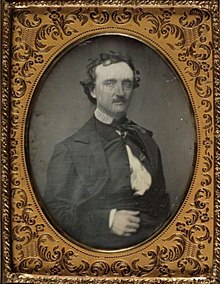Death of Edgar Allan Poe
Much of the extant information about the last few days of Poe's life comes from his attending physician, John Joseph Moran, though his credibility is questionable.
[6] No reliable evidence exists about his whereabouts until a week later on October 3, when he was found delirious in Baltimore at Ryan's Tavern (sometimes referred to as Gunner's Hall).
[8] His letter reads as follows: Dear Sir—There is a gentleman, rather the worse for wear, at Ryan's 4th ward polls, who goes under the cognomen of Edgar A. Poe, and who appears in great distress, & he says he is acquainted with you, and I assure you, he is in need of immediate assistance.
"[8] Snodgrass's first-hand account describes Poe's appearance as "repulsive", with unkempt hair, a haggard, unwashed face and "lusterless and vacant" eyes.
One possibility is that he was recalling an encounter with Jeremiah N. Reynolds, a newspaper editor and explorer who may have inspired the novel The Narrative of Arthur Gordon Pym of Nantucket.
He may have been delusional, thinking that his wife, Virginia Eliza Clemm Poe, was still alive, or he may have been referring to Sarah Elmira Royster, to whom he had recently proposed.
He also claimed that Poe had said, quite poetically, as he prepared to draw his last breath: "The arched heavens encompass me, and God has his decree legibly written upon the frontlets of every created human being, and demons incarnate, their goal will be the seething waves of blank despair."
The editor of the New York Herald, which published this version of Moran's story, admitted, "We cannot imagine Poe, even if delirious, constructing [such sentences].
"[19] Poe biographer William Bittner attributes Moran's claim to a convention of assigning pious last words to console mourners.
Many biographers have addressed the issue and reached different conclusions, ranging from Jeffrey Meyers' assertion that it was hypoglycemia to John Evangelist Walsh's conspiratorial murder plot theory.
[24] In 2020, a psychological analysis of Poe's language theorized that he was suffering from a major depressive episode near the end of his life and that suicide could not be ruled out.
[2] His drinking companion for a time, Thomas Mayne Reid, admitted that the two engaged in wild "frolics" but that Poe "never went beyond the innocent mirth in which we all indulge ...
[43] This was a ballot-box-stuffing scam in which victims were abducted off the street by local "election gangs", imprisoned in a small room called "the coop", drugged or forced with alcohol or beatings to get them to comply.
[36] Cooping, which would also explain the dirty and disheveled clothes and shoes that he was wearing when he was found, had become the standard explanation for Poe's death in most of his biographies for several decades,[44] though his status in Baltimore may have made him too recognizable for this scam to have worked.
[45] In an analysis published in the Maryland Medical Journal in 1996 by cardiologist R. Michael Benitez, it was suggested Poe's death most likely resulted from rabies, possibly contracted from one of his pets.
Also in attendance were Snodgrass, Baltimore lawyer and former University of Virginia classmate Zaccheus Collins Lee, Poe's first cousin Elizabeth Herring and her husband, and former schoolmaster Joseph Clarke.
"[50] Poe was buried at Westminster Presbyterian churchyard, in Baltimore, in a cheap coffin that lacked handles, a nameplate, cloth lining, or a cushion for his head.
[53] In 1873, Southern poet Paul Hamilton Hayne visited Poe's grave and published a newspaper article describing its poor condition and suggesting a more appropriate monument.
Sara Sigourney Rice, a Baltimore schoolteacher, took advantage of renewed interest in Poe's grave site and personally solicited for funds.
The new monument was designed by architect George A. Frederick and built by Colonel Hugh Sisson, and included a medallion of Poe by artist Adalbert Volck.
[56] Attendees included Neilson Poe, who gave a speech and called his cousin "one of the best hearted men that ever lived", as well as Snodgrass, Nathan C. Brooks and John Hill Hewitt.
[58] Alfred Tennyson contributed a poem which was read at the ceremony: Fate that once denied him, And envy that once decried him, And malice that belied him, Now cenotaph his fame.
Spence, the man who served as sexton during Poe's original burial as well as his exhumation and reburial, attended the rites that brought his body to rest with Virginia and her mother, Maria Clemm.
Signed only "Ludwig", the obituary floridly alternated between praising the dead author's abilities and eloquence and damning his temperament and ambition.
"Ludwig" said that "literary art lost one of its most brilliant, but erratic stars" but also claimed Poe was known for walking the streets in delirium, muttering to himself and that he was excessively arrogant, assumed all men were villains, and was quick to anger.
Many parts of it were believed to have been fabricated by Griswold, and it was denounced by those who had known Poe, including Sarah Helen Whitman, Charles Frederick Briggs, and George Rex Graham.
It also remained popular because many readers assumed that Poe was similar to his fictional characters[69] or were thrilled at the thought of reading the works of an "evil" man.
Even so, historians continued to use Griswold's depiction as a model for their own biographies of Poe, including W. H. Davenport in 1880, Thomas R. Slicer in 1909, and Augustus Hopkins Strong in 1916.
[70] In 1941, Arthur Hobson Quinn presented evidence that Griswold had forged and re-written a number of Poe's letters that were included in his "Memoir of the Author".



